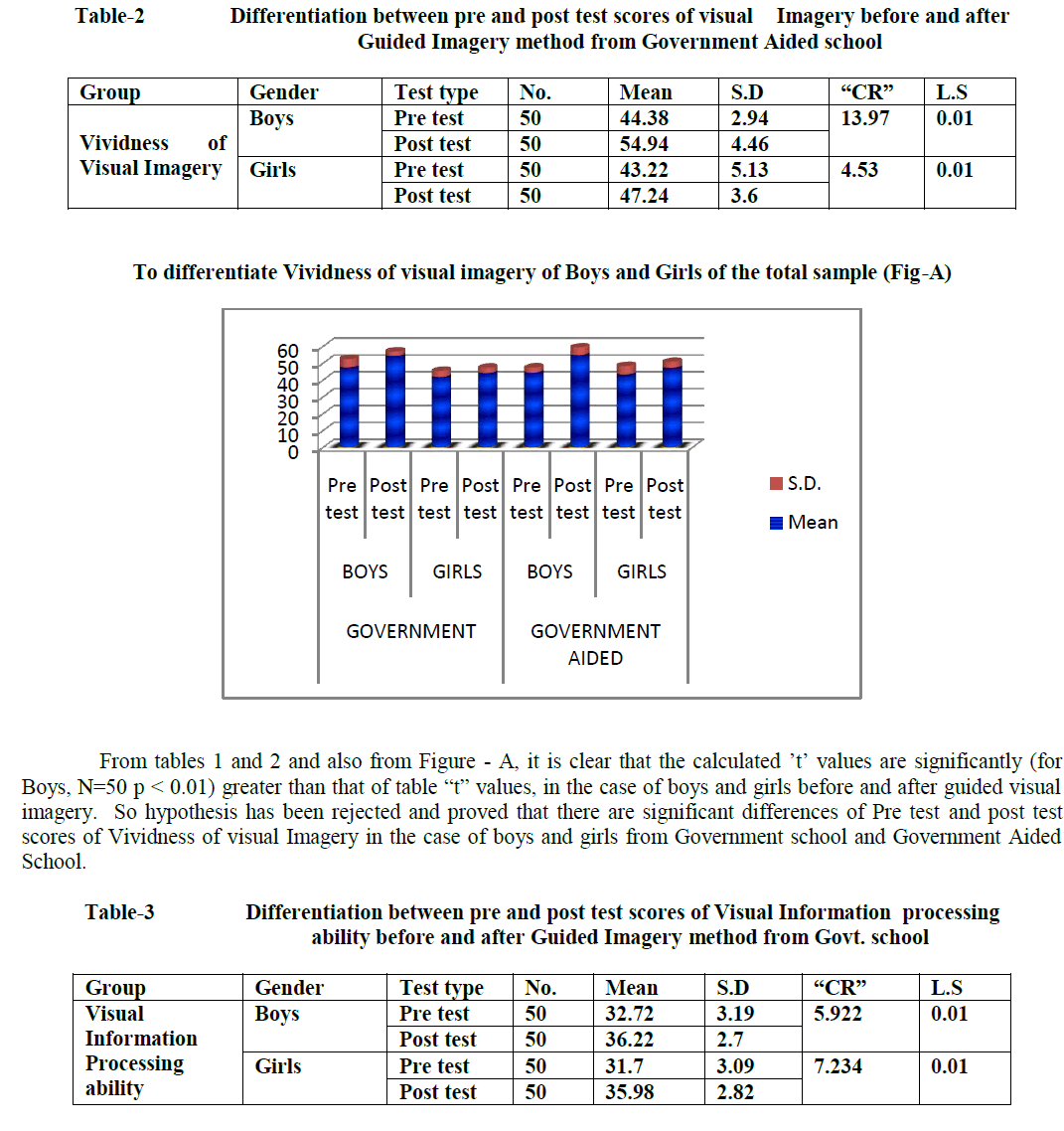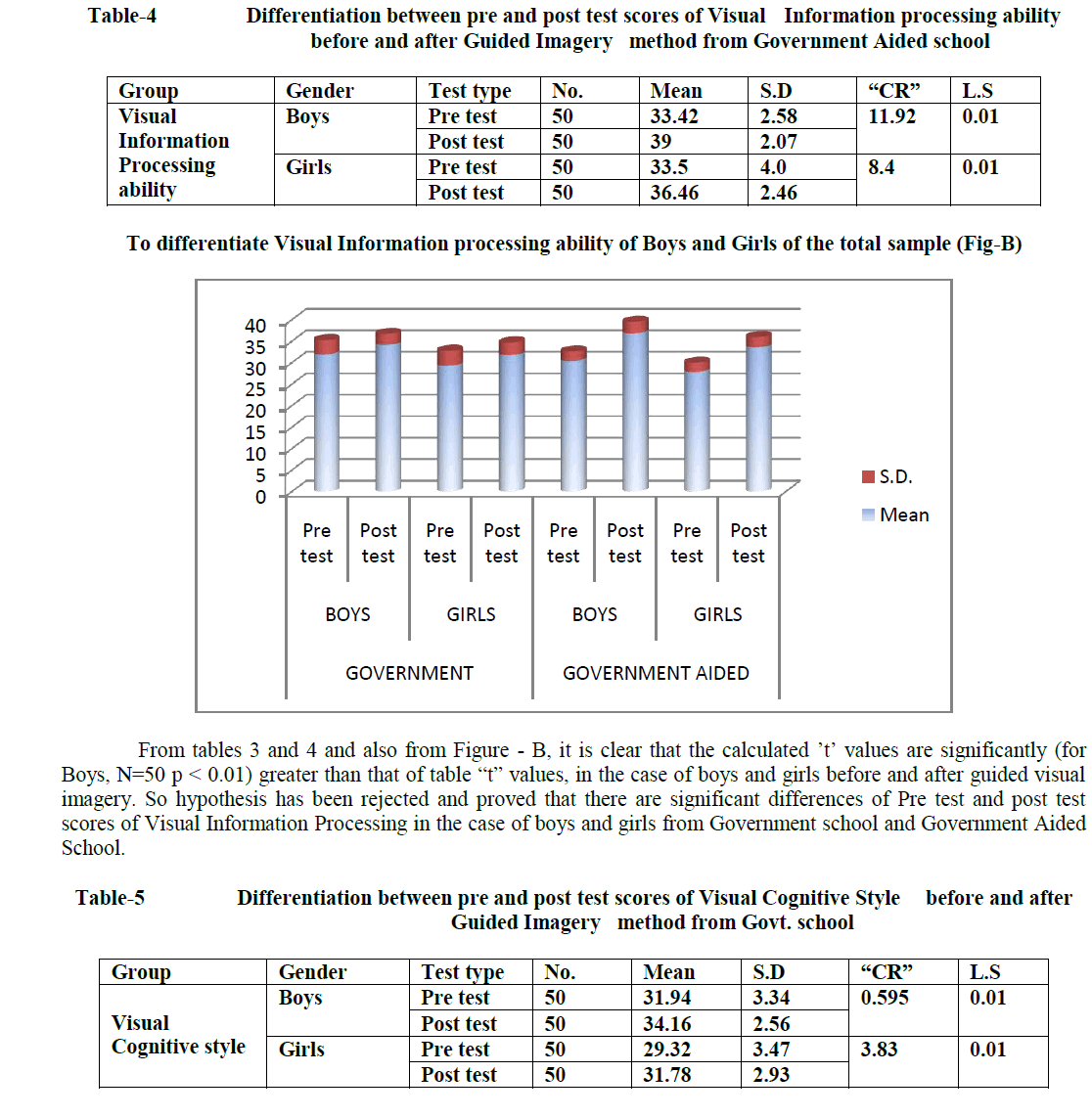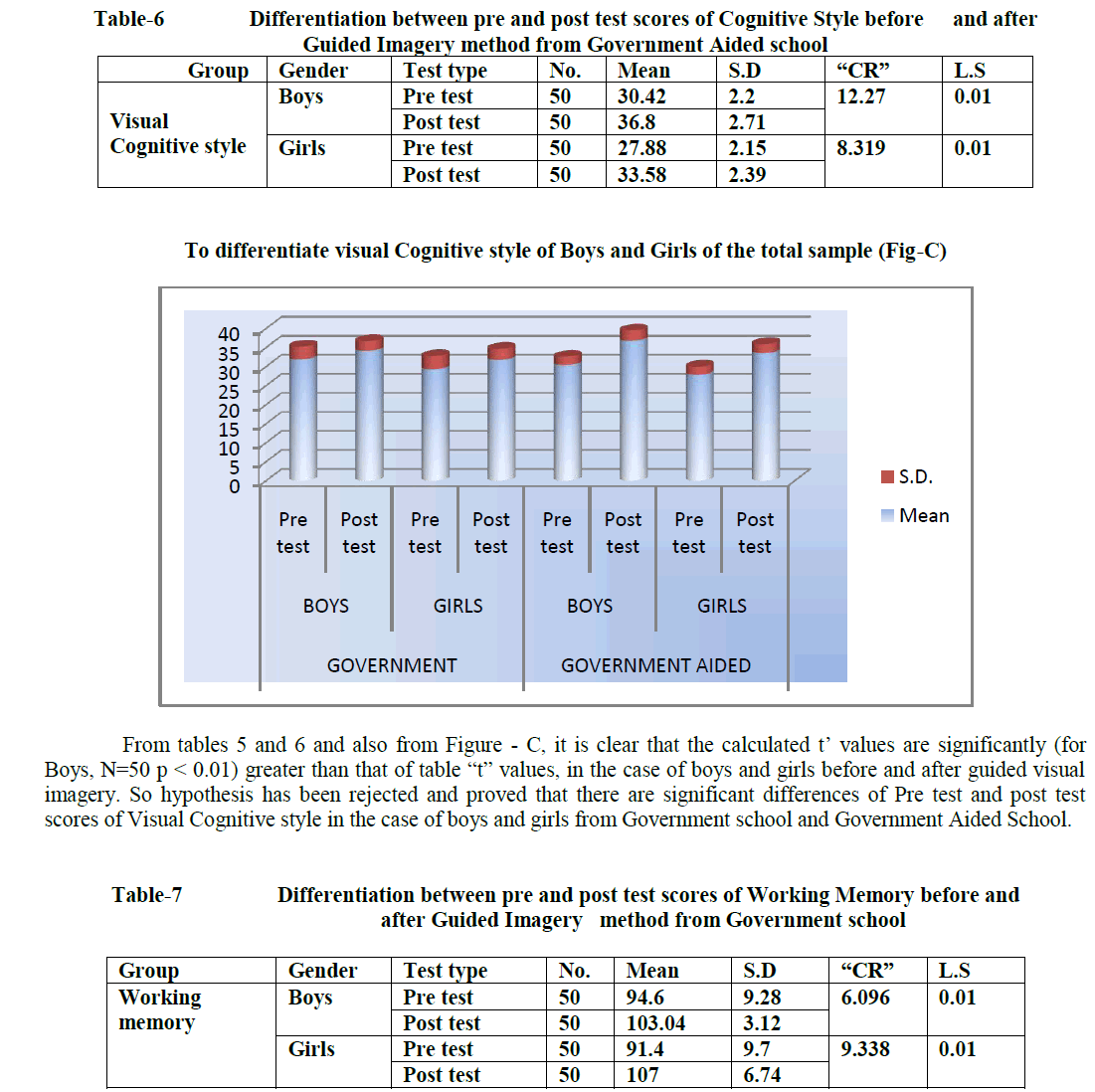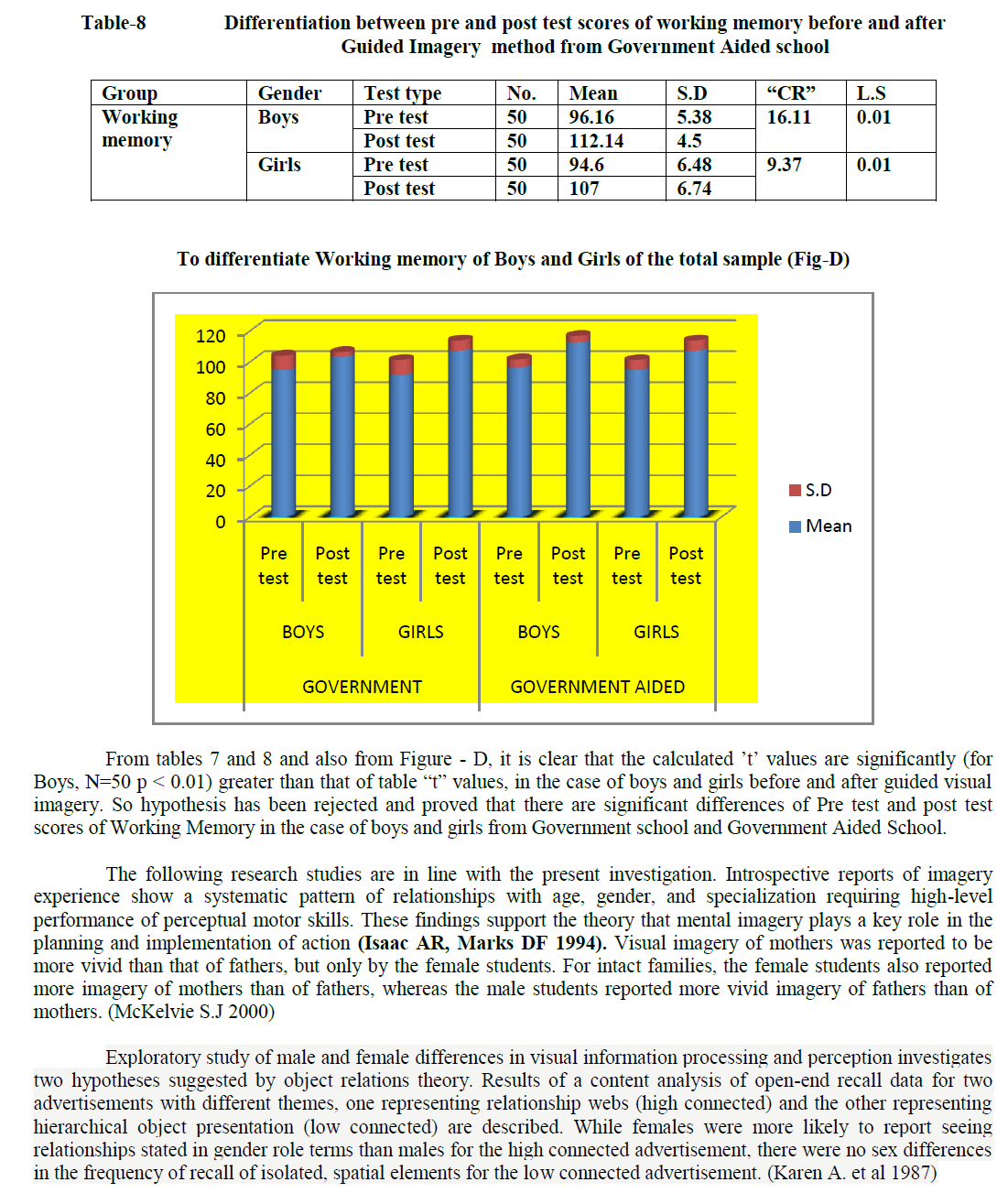ISSN ONLINE(2319-8753)PRINT(2347-6710)
ISSN ONLINE(2319-8753)PRINT(2347-6710)
P.A. Ramkumar 1, Dr. D. Hamalatha Kalaimathi 2
|
| Related article at Pubmed, Scholar Google |
Visit for more related articles at International Journal of Innovative Research in Science, Engineering and Technology
The study was designed to investigate the effect of Guided Imagery on the factors of vividness of visual imagery among Higher Secondary School students. Sample consists of 200 Higher Secondary School students. Tools chosen for the study were Vividness of visual Imagery questionnaire by David Marks (1973), Visual Information Processing ability questionnaire (Terry L. Childers et al) Visual Cognitive Style questionnaire by Revel and Norman, 1997) and Working memory scale by Dr. K. Saraladevi (2013). The means of the variables were recorded for pre test and post test. Statistical analyses were done on the different variable scores. It was found that guided visual imagery increase the level of vividness of visual imagery visual information processing ability, Visual Cognitive style and Working memory.
Keywords |
| Guided Imagery, vividness of visual imagery, Visual Information Processing ability, Visual Cognitive Style, and Working memory. |
INTRODUCTION |
| Guided imagery is a program of directed thoughts and suggestions that guide your imagination toward a relaxed, focused state. A mental image can be defined as “a thought with sensory qualities.” It is something we mentally see, hear, taste, smell, touch, or feel. |
| The term “guided imagery” refers to a wide variety of techniques, including simple visualization and direct suggestion using imagery, metaphor and story-telling, fantasy exploration and game playing, dream interpretation, drawing, and active imagination where elements of the unconscious are invited to appear as images that can communicate with the conscious mind. |
| Once considered an “alternative” “or complementary” approach, guided imagery is now finding widespread scientific and public acceptance, and it is being used to teach psycho physiological relaxation, alleviate anxiety and depression, relieve physical and psychological symptoms, overcome health-endangering habits, resolve conflicts, and help patients prepare for surgery and tolerate procedures more comfortably. |
| Visualization and imagery (sometimes referred to as guided imagery) techniques offer yet another avenue for stress reduction. These techniques involve the systematic practice of creating a detailed mental image of an attractive and peaceful setting or environment. Guided imagery can be practiced in isolation, but it is frequently paired with physical relaxation techniques such as progressive muscle relaxation and massage. When guided imagery is paired with physical relaxation techniques, the aim is to associate the sensations of relaxation with the peaceful visual image, so that future practice sessions involving imagery alone will quickly bring back to mind the physical sensations of relaxation. |
| Guided imagery techniques work to help people relax for several reasons. As is the case with many techniques, they involve an element of distraction which serves to redirect people's attention away from what is stressing them and towards an alternative focus. The techniques are in essence a non-verbal instruction or direct suggestion to the body and unconscious mind to act "as though" the peaceful, safe and beautiful (and thus relaxing) environment were real. Finally, guided imagery can work through the associative process described above, where scenes become a learned cue or trigger that helps recall memories and sensations resulting from past relaxation practice. |
| The practice of guided imagery is extremely portable, as it relies on nothing more than one's imagination and concentration abilities which people always have at their disposal (provided they aren't exhausted). However, like most techniques requiring mental concentration, it is usually most successfully practiced without interruption in a setting that is free from distracting stimulation. The bathroom can be used in a pinch, if no other suitably private and peaceful location is available. |
| Imagery processing has been recognized as superior to discursive (or verbal) processing and thus has become an important tool in designing advertising. Evidence suggests that imagery-producing ads result in superior recall and more positive attitudes toward the product. However, there has been limited examination of the relationship between imagery and behavioral intentions. We investigate this latter relationship going beyond other research in the area by examining imagery content. Specifically, we report the results of an experiment which tests the effects of three message-relevant factors on behavioral intentions: (1) self-relatedness, (2) plausibility, and (3) distinctiveness. |
| Terms such as imagery, visualization, mental practice, and mental rehearsal have been used interchangeably among researchers to describe a powerful mental training technique (Taylor & Wilson, 2005). In its early developments, mental practice and mental rehearsal were terms used to describe the technique of mental imagery, but these terms only referred to a general description of the strategy of rehearsing a skill mentally before the completion of a physical task, without clearly describing how it is rehearsed and what sensory or cognitive modalities were used (Taylor & Wilson, 2005). Presently, most practitioners use the broader term mental imagery to describe structured mental practice techniques to create or recreate an athletic performance (Holmes & Collins, 2001; Vealey & Greenleaf, 1998). With these ideas in mind the investigator has chosen the topic as Guided Imagery on the factors of vividness of visual imagery. Visual Information Processing ability, Visual cognitive style and Working memory are the factors considered for vividness of visual imagery in this investigation. |
RELATED WORK |
| D Lehmann et al (1998) prompted reports of recall of spontaneous, conscious experiences were collected in a no-input, no-task, no-response paradigm (30 random prompts to each of 13 healthy volunteers). The mentation reports were classified into visual imagery and abstract thought. Spontaneous 19-channel brain electric activity (EEG) was continuously recorded, viewed as series of momentary spatial distributions (maps) of the brain electric field and segmented into microstates, i.e. into time segments characterized by quasi-stable landscapes of potential distribution maps which showed varying durations in the sub-second range. Microstate segmentation used a data-driven strategy. Different microstates, i.e. different brain electric landscapes must have been generated by activity of different neural assemblies and therefore are hypothesized to constitute different functions. The two types of reported experiences were associated with significantly different microstates (mean duration 121 ms) immediately preceding the prompts; these microstates showed, across subjects, for abstract thought (compared to visual imagery) a shift of the electric gravity center to the left and a clockwise rotation of the field axis. Contrariwise, the microstates 2 s before the prompt did not differ between the two types of experiences. The results support the hypothesis that different microstates of the brain as recognized in its electric field implement different conscious, reportable mind states, i.e. different classes (types) of thoughts (mentations); thus, the microstates might be candidates for the `atoms of thought'. |
| William L. Thompson (2011) Visual mental imagery (which involves creating, interpreting, and transforming visual mental representations, i.e., “seeing with the mind's eye”) and visual attention typically are described as distinct processes. However, some researchers have claimed that imagery effects can be explained by appeal to attention (and thus, that imagery is nothing more than a form of attention). In this study, we used a size manipulation to demonstrate that imagery and attention are distinct processes. We reasoned that if participants are asked to perform each function (imagery and attention) using stimuli of two different sizes (large and small), and that stimulus size affects the two functions differently, then we could conclude that imagery and attention are distinct cognitive processes. Our analyses showed that participants performed the imagery task better when stimuli were large, whereas they performed the attention task better when stimuli were small. This finding demonstrates that imagery and attention are distinct cognitive processes. George, Grovios (1989) investigated (i) the effect of mental rehearsal on Reaction time and the rate of cerebral lateralization. Memory verbal and Non verbal process in MR effects 300 sports participants matched on age Sill level, sex motivation and speed of reaction. It was found that (a) MR can affect significantly RT (p, 0.01) because it is powerful cognitive Activity which can directly influence the memory system. (b) Non Verbal Processing system probably because it use an effecting processing strategy and that MR effects significantly (p, 0.01) and the balance Stabilometer. It also appears that neither of the adjunct procedures facilitated the effects of mental practice. Hypnosis neither affected Imagery vividness nor aided in the retention of balance stabilometer Performance of any of the subjects. |
| A systematic review of three studies investigating imagery, hypnosis and relaxation training with immune system activity demonstrated that relaxation and guided imagery improved mood, anxiety, and depression and enhanced immune function in terms of fewer viral infections (Gruzelier, 2002) |
| In a case study, one Woman with severe dermatomyositis associated with stress used transcendental meditation and visual imagery that resulted in her recovery without use of corticosteroids. The cumulative beneficial influences of imagery and meditation outweighed the negative impact of stress (Collins & Dunn, 2005) |
| The issue of information processing style can be extended to individual differences in mental imagery processing. The study of individual differences in imagery processing has evoked a lot of interest. For instance, Ernest (1977) acclaimed that individual differences in imagery processing can have significant influences on a range of cognitive functions such as learning, memory, perception, and problem solving. Zins (2003) stated that adapting Web sites to the cognitive style of their users improves the quality of the human-computer interaction. According to the literature, individual differences in mental imagery processing encompass three different aspects: 1) imagery vividness; 2) Imagery control; and, 3) imagery processing style. Mental Imagery vividness relates to the clarity of the mental images evoked by an individual (Childers et al., 1985) or the liveliness and similarity to the actual percept (Marks, 1973). It has been identified as a major dimension of imagery (Babin & Burns, 1998). There are two scales which have been widely used in order to measure individual differences in imagery vividness (MacInnis, 1987). Besides the scales of vividness and imagery control designed to assess individual differences in abilities to imagine, several measures have also been proposed to assess differences in individuals' preferences and propensities for using memory (MacInnis, 1987). Paivio (1971) and Richardson (1978) define imagery processing style as individuals' tendencies and preferences for processing information visually or verbally. It was demonstrated by Childers et al. (1985) that individual differences exist in terms of willingness to habitually engage in visually- versus verbally-oriented processing. In the study of, Dag Körlin & Björn Wrangsjö (2009) they have explored gender differences in outcome of Guided Imagery and Music (GIM) therapy with a potentially gender sensitive instrument, the Inventory of Interpersonal Problems (UP), as well as the symptom checklist –90 (SCL–90) and Sense of coherence (SOC) scale. In these conditions, women benefited more than men in relational aspects measured by the IIP. In the SOC, there were gender differences in subscale effects consistent with current assumptions of gender roles. There was also support for the observation that men have a higher threshold for seeking psychotherapeutic treatment. The findings encourage the development of a more multi–faceted perspective on how the gender dimension can help to improve the fit in the therapeutic relationship and improve the client's benefit of the treatment. |
SAMPLE |
| 200 students were chosen for the study and their age is ranging from 16 to 18 years, from Government and Government Aided School located in Thiruvallur District, Tamilnadu. 100 students (50 boys and 50 girls) from Government School and 100 students (50 boys and 50 girls) from Government Aided School were selected for experimental study. Investigator conducted pre-test to judge the academic performance of the students and psychological factors namely cognitive style, Visual Information processing and Working memory. The investigator selected XI standard Commerce students. While teaching the concepts the Investigator trained experimental group with all the guided imagery techniques. The investigator explained the students the application of each and every technique elaborating its significance considering the psychological factors for a period of one month. Finally on completion of one month a post test was conducted to find any significant variation in the scores of Psychological variables as well as scores of academic performance. |
STATEMENT OF THE PROBLEM |
| Guided Imagery on the Factors of Vividness of Visual Imagery is the topic chosen the study. |
OBJECTIVES OF THE STUDY |
| Tto find out the impact of guided imagery on factors of Vividness of visual Imagery. |
HYPOTHESES |
| 1. there are no significant differences between Pre test and Post Test scores of Vividness of visual Imagery |
| 2. There are no significant differences between Pre test and Post Test scores of Visual cognitive style |
| 3. There are no significant differences between Pre test and Post Test scores of, visual Information Processing Ability |
| 4. There are no significant differences between Pre test and Post Test scores of and Working Memory |
DESIGN OF THE STUDY |
| Experimental design has been selected for the present study. 200 students (age range 16-18yrs.) were selected and they were given Vividness of visual Imagery questionnaire by David Marks (1973), Visual Information Processing ability questionnaire (Terry L. Childers et al) Visual Cognitive Style questionnaire by Revell and Norman, 1997) and Working memory scale by K. Saraladevi & Nithiya Amirtham ( 2013). Test groups were given with guided visual. imagery for about 4 weeks. Post test scores were collected on Vividness of visual Imagery, Visual Information Processing ability, Visual Cognitive Style, and Working memory. Quasi experimental design was usedfor this investigation |
 |
 |
 |
 |
 |
| Chorow’s (1978) explanation of male and female cognitive differences focuses on women being the primary caretakers of infants in the Western culture. Thus, the importance of the female during infancy results in children of both sexes psychologically comparing themselves to a female. The meaning children ascribe to this process and its subsequent impact on the continuing development of cognitive strategies is generally different for girls than for boys (i.e., girls might see themselves as similar to the female and boys might see themselves as different from the female). Specifically, the ongoing mother-daughter attachment reproduces the social arrangement whereby women continue to be the primary figures in the lives of infants of both sexes. |
| Rubin, whose orientation is primarily clinical, believes that themes of separation (for boys) and unity (for girls) are incorporated into the personality structure at a pre-oedipal age and that these differences affect crucial parts of the lives of both men and women (Rubin 1983). Gilligan (1982), however, draws upon the "texts of men's and women's fantasies" to specifically elaborate these themes into images of a web of connected relationships (empirically associated primarily with women) or a hierarchy of object separation (empirically associated primarily with men). |
| Gilligan (1982) examined the different cognitive schemes used by males and females as they pertain to moral judgment and subsequent action in life or death situations. Briefly, Gilligan (1982) studied males and females of different ages to examine their cognitive processes. She found that younger females tended to process information in the context of social relationships or what Gilligan refers to as the "web". For females, connectedness to other people was the most important criteria for decision-making. Males, however, tented to look at situations as distinct from social relationships and as isolated, abstract events to be approached "logically”. |
| From a neuro imaging perspective, recent research has shown that there are gender differences in functional connectivity during resting state (Filippi et al., 2013). Specifically, Filippi and colleagues (2013) found that women had greater intrinsic functional connectivity inclusive of the cingulated, dorsolateral prefrontal cortex, and the inferior frontal gyrus, while men demonstrated increased functional connectivity in parietal regions, characteristics that the authors attribute to potential strategy differentiation. |
RESULTS |
| 1. That there are significant differences of Pre test and post test scores of Vividness of visual Imagery in the case of boys and girls from Government school and Government Aided School. |
| 2. There are significant differences of Pre test and post test scores of Visual Information Processing in the case of boys and girls from Government school and Government Aided School. |
| 3. There are significant differences of Pre test and post test scores of Visual Cognitive style in the case of boys and girls from Government school and Government Aided School. |
| 4. There are significant differences of Pre test and post test scores of working memory in the case of boys and girls from Government school and Government Aided School. |
DISCUSSION |
| Guided imagery technique changes the scores of Vividness of visual Imagery, Visual Information Processing ability, Visual Cognitive Style, and Working memory. The goal of guided imagery technique is to increase the level of cognitive style thro information processing and working memory. |
| Students can employ at least two different strategies in comprehending the description of a social event. On one hand, they might interpret the information in terms of semantic concepts pertaining to the type of event described or the situation in which it occurred. In this case, their reactions to the event are likely to be similar regardless of the form in which the information is presented. Alternatively, recipients might try to form a visual image of the event being described and base their reactions on this image. In this case, their reactions are likely to depend on characteristics of the information that influence the type of image they construct and the difficulty of forming it. The tendency to construct visual images from verbal information can depend on how the information is presented. Adaval and her colleagues (Adaval, Isbell, & Wyer, 2007; see also Adaval & Wyer, 1998) researchers have reported that when individuals engage in vivid imagery, their brains interpret these images as identical to the actual stimulus situation (Marks, 1983). Imagery is reliant on experiences stored in memory, and participants experience it internally by reconstructing external events in their minds. However, imagery can be used to create new experiences by putting together pieces of any internal picture in various ways (Vealey & Greenleaf, 2006). The goal of mental imagery is to produce the athletic experience so accurately that athletes feel as if they are actually performing the sport (Hale, 1998; Holmes & Collins, 2001). The symbolic perceptual theory claims that behavior change related to mental imagery is a factor of the cognitive elements of the researchers have provided support for the proposition that mental practice alone may be sufficient enough to promote the activation of the neural circuits involved in the early stages of learning new motor skills (Feltz & Landers, 1983; Martin et al., 1999) task. Therefore, effectiveness of imagery is dependent upon the amount of cognitive demands a task has (Denis, 1985). In this perspective, mental imagery allows the individual to gain additional cognitive insight which could help them in their performance. Gambrel et al. (1986) stated that mental imagery should receive attention in instructional methodology texts as a viable comprehension strategy. Professional books compiling teacher action-research appear to be a well-respected source of imagery knowledge by teachers. The implication of this finding is that teachers everywhere can learn about imagery through any avenues open to them. An awakening to the value of imagery could literally rise up from the dust of rural schools or from the concrete playgrounds of inner city schools! Workshops could offer succinct information about imagery research, theory, and proven “best practices” techniques. Workshops could be requested by teachers, curriculum resource personnel, or administration. Some teachers would rather hear about imagery and see “how to” videos showing teachers in action, than to spend time reading a book or article. Handouts could preserve the essence of the information for future study along with a list of books and websites that address imagery techniques... |
DELIMITATIONS |
| 1. Only Higher secondary commerce students were taken for research. |
| 2. Aspects like economic background, surroundings were not taken into account. |
| 3. Sample collected in Thiruvallur District only. |
LIMITATIONS |
| 1. The investigator would have increased the sample size. |
| 2. Other type of schools would have been incorporated for research |
| 3. This study can also be extended to other Districts. |
| 4. Therapeutic technique of guided imagery can be extended for 3 months in order to see better results of variables. |
| 5. The impact of guided imagery on brain waves would have been done. |
CONCLUSIONS |
| 1. there are significant differences between Pre test and Post Test scores of Vividness of visual Imagery |
| 2. There are significant differences between Pre test and Post Test scores of Visual cognitive style |
| 3. There are significant differences between Pre test and Post Test scores of, visual Information Processing Ability |
| 4. There are significant differences between Pre test and Post Test scores of and Working Memory From this It has been concluded that guided imagery has an impact on vividness of visual imagery, visual information ability, visual cognitive style and working memory. |
References |
|